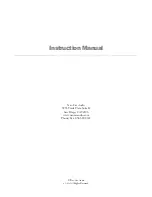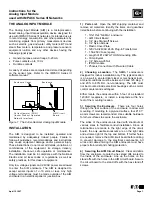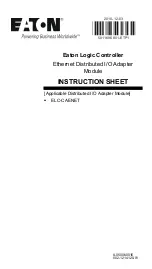
26
RO TROUBLE SHOOTING GUIDE
SYMPTOMS
Salt Passage
Permeate Flow
Pressure Drop
Location
Possible Causes
Verification
Corrective Action
Normal to
increased
Decreased
Normal to
increased
Predominantly
first stage
Metal oxide
Analysis of metal ions in
cleaning solution.
Improved pretreatment to remove metals.
Cleaning with acid cleaners.
Normal to
increased
Decreased
Normal to
increased
Predominantly
first stage
Colloidal fouling
SDI measurement of feed/
X-ray diffraction analysis of
cleaning sol. Residue.
Optimize pretreatment system for colloidal
removal. Clean with high pH, anionic
detergent formulation.
Increased
Decreased
Increased
Predominantly
last stage
Scaling
(CaSO4, CaSO3,
BaSO4, SiO2)
Analysis of metal ions in
cleaning sol. Check LSI of
reject. Calculate maximum
solubility for CaSO4, BaSO4,
SiO2 in reject analysis.
Increase acid addition and scale inhibitor
for CaSO3 and CaSO4. Reduce recovery.
Clean with an acid formulation for CaCO3,
CaSO4 and BaSO4.
Normal to
moderate
increase
Decreased
Normal to
moderate
increase
Can occur in
any stage
Biological fouling
Bacteria count in permeate
and reject. Slime in pipes
and vessels.
Shock dosage of sodium bisulfite.
Continuous feed of low conc. Of bisulfite
at reduced pH. Formaldehyde sterilization.
Clean with alkaline anionic surfactant.
Chlorine dosage up-stream with subs.
Dechlorination. Replace cartridge filters.
Decreased or
moderately
increased
Decreased
Normal
All stages
Organic fouling
Destructive testing, e.g. IR
reflection analysis.
Optimization of pretreatment system
(e.g. coagulation process.) Resin/activated
carbon treatment. Clean with high
pH detergent.
Increased
Increased
Decreased
Most severe in the
first stage
Chlorine oxidant attack
Chlorine analysis of feed.
Destructive element test.
Check chlorine feed equipment and
dechlorination equipment.
Increased
Increased
Decreased
Most severe in the
first stage
Abrasion of membrane
by crystalline material
Microscopic solids analysis of
feed. Destructive element test.
Improved pretreatment. Check all filters for
media leakage.
Increased
Normal to
increased
Decreased
At random
O-ring leaks, End or side
seal glue leaks.
Probe test. Vacuum test.
Colloidal material passage.
Replace O-rings. Repair or replace elements.
Increased
Normal to low
Decreased
All stages
Conversion too high.
Check flows and pressures
against design guidelines
Reduce conversion rate. Calibrate sensors.
Increase analysis and data collection.
Troubleshooting
Summary of Contents for Pure Water PWR4021 Series
Page 6: ...6 Figure 2 B Controller Drawing...
Page 7: ...7 B Controller Drawing continued Figure 3...
Page 13: ...13 Figure 6 Wiring Diagram Pictorial Schematic of a Typical ROC 4 System...
Page 15: ...15 Figure 8 Controller Detail Terminal Board TB 3 See Fig 3 for schematic TB24V3...
Page 20: ...20 Figure 11 Controller Programming Menu Navigation...
Page 31: ...31 Notes...







































